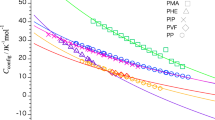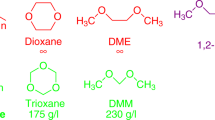Abstract
POLYTETRAFLUOROETHYLENE is notable among addition polymers for its high thermal stability. It decomposes at temperatures above about 400° C. to give tetrafluoroethylene as primary product1. It seems possible to account for this high stability in thermodynamic terms. A useful, though arbitrary, measure of the ultimate stability of a polymer, or more correctly of its free radical form, with respect to its monomeric precursor, is the temperature at which a particular pressure of monomer is supported over the polymer. This is given by2:  where δH
gc and δS
gc are the heat and entropy of polymerization for the chosen monomer pressure at a suitable temperature, conveniently taken as 25° C. in most cases. Thus the ultimate stability is determined by the heat of polymerization of the monomer (which is in the range −16 to −25 kcal./mole for most monomers), and the entropy of polymerization (which increases with the molecular weight and complexity of the monomer). The heats of formation of tetrafluoroethylene and of its polymer (−152 kcal./mole3 and −199 kcal./tetrafluoroethylene mole unit4, respectively) give the heat of polymerization of tetrafluoroethylene as about −47 kcal./mole. The entropy of polymerization at 67° C. (which temperature is chosen to avoid anomalies resulting from the second-order phase transition of the polymer at room temperature), derived from the measured entropies of monomer5 and polymer6, is about −45 entropy units/mole for one atmosphere pressure of monomer. These compare with the values7 δH
gc = −24.7 kcal./mole and δS
gc = − 37 e.u./mole for ethylene at 25° C., and account for the strikingly greater thermal stability of tetrafluoroethylene.
where δH
gc and δS
gc are the heat and entropy of polymerization for the chosen monomer pressure at a suitable temperature, conveniently taken as 25° C. in most cases. Thus the ultimate stability is determined by the heat of polymerization of the monomer (which is in the range −16 to −25 kcal./mole for most monomers), and the entropy of polymerization (which increases with the molecular weight and complexity of the monomer). The heats of formation of tetrafluoroethylene and of its polymer (−152 kcal./mole3 and −199 kcal./tetrafluoroethylene mole unit4, respectively) give the heat of polymerization of tetrafluoroethylene as about −47 kcal./mole. The entropy of polymerization at 67° C. (which temperature is chosen to avoid anomalies resulting from the second-order phase transition of the polymer at room temperature), derived from the measured entropies of monomer5 and polymer6, is about −45 entropy units/mole for one atmosphere pressure of monomer. These compare with the values7 δH
gc = −24.7 kcal./mole and δS
gc = − 37 e.u./mole for ethylene at 25° C., and account for the strikingly greater thermal stability of tetrafluoroethylene.
This is a preview of subscription content, access via your institution
Access options
Subscribe to this journal
Receive 51 print issues and online access
$199.00 per year
only $3.90 per issue
Buy this article
- Purchase on Springer Link
- Instant access to full article PDF
Prices may be subject to local taxes which are calculated during checkout
Similar content being viewed by others
References
Madorsky, S. L., Hart, V. E., Straus, S., and Sedlak, V. A., J. Res. Nat. Bur. Stand., 51, 327 (1953).
Dainton, F. S., and Ivin, K. J., Trans. Farad. Soc., 46, 331 (1950).
Neugebauer, G. A., and Margrave, J. L., J. Phys. Chem., 60, 1318 (1956).
Duus, H. C., Indust. Eng. Chem., 47, 1445 (1955).
Mann, D. E., Acquista, N., and Plyler, E. K., J. Res. Nat. Bur. Stand., 52, 67 (1954).
Furukawa, G. T., McCoskey, R. E., and King, G. T., J. Res. Nat. Bur. Stand., 49, 273 (1952).
Dainton, F. S., Devlin, T. R. E., and Small, P. A., Trans. Farad. Soc., 51, 1710 (1955).
Author information
Authors and Affiliations
Rights and permissions
About this article
Cite this article
PATRICK, C. Thermal Stability of Polytetrafluoroethylene. Nature 181, 698 (1958). https://doi.org/10.1038/181698a0
Published:
Issue Date:
DOI: https://doi.org/10.1038/181698a0
This article is cited by
Comments
By submitting a comment you agree to abide by our Terms and Community Guidelines. If you find something abusive or that does not comply with our terms or guidelines please flag it as inappropriate.



